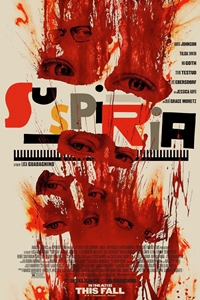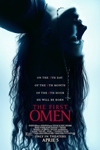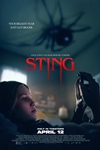Suspiria (R) ★½
 If I wanted to be kind, I'd call Luca Guadagnino's Suspiria remake "visually striking" and "stylish." If I wanted to be brutally honest, I'd call it "tedious", "pretentious", and even "painful" (although not in a good way). Any successful horror film, whether high-brow art or low-brow exploitation, makes the viewer feel something. Yet about the only emotional response provoked by this overlong slog is apathy. Watching Suspiria, I was reminded more of The Neon Demon (which I hated) and mother! (about which I was ambivalent but would never claim to like) than the 1977 gore-soaked Dario Argento cult-classic original.
If I wanted to be kind, I'd call Luca Guadagnino's Suspiria remake "visually striking" and "stylish." If I wanted to be brutally honest, I'd call it "tedious", "pretentious", and even "painful" (although not in a good way). Any successful horror film, whether high-brow art or low-brow exploitation, makes the viewer feel something. Yet about the only emotional response provoked by this overlong slog is apathy. Watching Suspiria, I was reminded more of The Neon Demon (which I hated) and mother! (about which I was ambivalent but would never claim to like) than the 1977 gore-soaked Dario Argento cult-classic original.
Although the core story in Suspiria borrows from its predecessor, Guadagnino and screenwriter David Kajganich graft on two subplots that, although intended to add meaning and thematic depth, turn what was originally a pretty straightforward (albeit surreal) yarn into a muddled allegory that devolves into macabre self-parody during its final act. The movie, which transpires in October 1977 in Berlin, occurs against the backdrop of the hijacking of Lufthansa Flight 181. The amount of time Suspiria expends following the development of this historical event indicates that there's intended to be a connection between it and the main narrative, but I'll be damned if I know what it is. The movie also introduces a psychologist character who lost his wife in World War 2. His inclusion seems designed exclusively to provide actress Tilda Swinton with a chance to don a prosthetic penis and play a man. (As a side note, his wife is portrayed by Jessica Harper, who was the lead in the Argento film.)
Suspiria's supporters will argue that the movie's somnambulant first half represents a "slow burn" necessary to build up to the "shocking" twists and revelations at the end. Unfortunately, the "burn" is so slow that it comes to a complete stop. Guadagnino will have lost most of his audience before he increases the pace (and, when he does so, it's only by a little). Although parts of the ending are incomprehensible, those that make a modicum of sense are ludicrous and unsatisfying. This is what happens when a new screenwriter tosses out the original climax and replaces it with something of his own devising. And, although Guadagnino's imagery is suitably creepy and unsettling during what I'll call the "final performance," the seriousness with which he approaches the material is unintentionally borderline comical. Gone are the echoes of black humor and bloody exuberance embraced by Argento. This Suspiria wants to be seen as serious art - demented, perhaps, but infused with meaning. Not even mother! had such aspirations.
Most of the "action" transpires within the Markos Dance Academy, which exists just west of the Berlin Wall. (The recreations of Cold War Germany are impressive.) Susie Bannion (Dakota Johnson), a Dorothy-like dancer from Ohio, arrives there for an audition. After impressing the company's director, Madame Blanc (Tilda Swinton), with her raw ability, she is offered a position. After only a few days, she has moved up Mme. Blanc's list of favorites and has been given the lead. All is not well at the Markos Academy, however. The previous lead, Patricia (Chloe Grace Moretz), has experienced a breakdown and disappeared. Her best friend, Sara (Mia Goth), while investigating what happened to her friend, discovers what she believes to be evidence of a coven of witches operating within the Academy. When she confronts Patricia's psychologist, Dr. Joseph Klemperer (Swinton, using the alias of "Lutz Ebersdorf"), with her suspicions, he acknowledges that his patient confided in him about her "delusions" but he dismissed them. Now, he's no longer sure...
For all that Suspiria fails as a drama, a character piece, or (most importantly) a horror movie about bloodthirsty, body-snatching witches, the dance performances are effective. These sequences, which sadly are few and far between, shake the movie into wakefulness with a jolt of energy. Partway through, I found myself wondering whether Guadagnino might be a better match for a remake of Showgirls than Suspiria. The director's involvement seems an odd match; anyone expecting something along the lines of Call Me By Your Name will be left wanting. It's as if the two movies were made by different craftsmen.
Dakota Johnson's performance, although lively and athletic during the dance sequences, leaves a bit to be desired in subdued moments. Susie is flat and artificial and, although part of the blame goes to the director and screenwriter, Johnson doesn't compensate for those deficiencies. Tilda Swinton is expectedly weird but there's nothing standout about her performance except that she's passable as a man (no longer an impressive feat in this era of motion capture and CGI, although neither was used in this case). Chloe Grace Moretz has minimal screen time and, during her one significant scene, she's not recognizable.
The good thing for anyone with a morbid curiosity to see this interminable ruin of a film is that it has been produced by Amazon Studios and, as a result, will soon be available for free streaming for anyone with an Amazon Prime account. At 152 minutes, the movie is broken into six acts (plus an epilogue) - sleeping through (or skipping) a few of those acts might cause some confusion but will also reduce the amount of time invested/wasted. I'd suggest applying the mother! litmus test. Those who loved Darren Aaronofsky's bizarre plunge into surreal horror might appreciate where Guadagnino has taken Suspiria. Nearly everyone else will find that this deserves the derision and disdain it will receive from mainstream movie-goers nationwide.
© 2018 James Berardinelli
To get the full Quicklook Films experience, uncheck "Enable on this Site" from Adblock Plus
box office top 10

Civil War Released: April 12, 2024 Cast: Kirsten Dunst, Wagner Moura 25.7M

Godzilla x Kong: The New Empire Released: March 29, 2024 Cast: Rebecca Hall, Brian Tyree Henry 15.5M

Ghostbusters: Frozen Empire Released: March 22, 2024 Cast: Paul Rudd, Carrie Coon 5.8M

Kung Fu Panda 4 Released: March 8, 2024 Cast: Jack Black, Viola Davis 5.5M

Dune: Part Two Released: March 1, 2024 Cast: Timothée Chalamet, Rebecca Ferguson 4.3M

Monkey Man Released: April 5, 2024 Cast: Dev Patel, Sikandar Kher 4.1M

The First Omen Released: April 5, 2024 Cast: Nell Tiger Free, Bill Nighy 3.8M

The Long Game Released: April 12, 2024 Cast: Dennis Quaid, Gillian Vigman 1.4M

Shrek 2 Released: May 19, 2004 Cast: Mike Myers, Eddie Murphy 1.4M

Sting Released: April 12, 2024 Cast: Alyla Browne, Ryan Corr 1.2M






